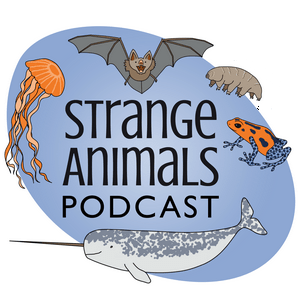Episode 440: Trilobites!
Thanks to Micah for suggesting this week's topic, the trilobite!
Further reading:
The Largest Trilobites
Stunning 3D images show anatomy of 500 million-year-old Cambrian trilobites entombed in volcanic ash
Strange Symmetries #06: Trilobite Tridents
Trilobite Ventral Structures
A typical trilobite:
Isotelus rex, the largest trilobite ever found [photo from the first link above]:
Walliserops showing off its trident [picture by TheFossilTrade - Own work, CC BY-SA 4.0, https://commons.wikimedia.org/w/index.php?curid=133758014]:
Another Walliserops individual with four prongs on its trident [photo by Daderot, CC0, via Wikimedia Commons]:
Show transcript:
Welcome to Strange Animals Podcast. I’m your host, Kate Shaw.
This week we’re going to learn about an ancient animal that was incredibly successful for millions of years, until it wasn’t. It’s a topic suggested by Micah: the trilobite.
Trilobites first appear in the fossil record in the Cambrian, about 520 million years ago. They evolved separately from other arthropods so early and left no living descendants, that they’re not actually very closely related to any animals alive today. They were arthropods, though, so they’re distantly related to all other arthropods, including insects, spiders, and crustaceans.
The word trilobite means “three lobes,” which describes its basic appearance. It had a head shield, often with elaborate spikes depending on the species, and a little tail shield. In between, its body was segmented like a pillbug’s or an armadillo’s, so that it could flex without cracking its exoskeleton. Its body was also divided into three lobes running from head to tail. Its head and tail were usually rounded so that the entire animal was roughly shaped like an oval, with the head part of the oval larger than the tail part. It had legs underneath that it used to crawl around on the sea floor, burrow into sand and mud, and swim. Some species could even roll up into a ball to protect its legs and softer underside, just like a pillbug.
Because trilobites existed for at least 270 million years, there were a lot of species. Scientists have identified about 22,000 different species so far, and there were undoubtedly thousands more that we don’t know about yet. Most are about the size of a big stag beetle although some were tinier. The largest trilobite found so far lived in what is now North America, and it grew over two feet long, or more than 70 centimeters, and was 15 inches wide, or 40 cm. It’s named Isotelus rex.
I. rex had 26 pairs of legs, possibly more, and prominent eyes on the head shield. Scientists think it lived in warm, shallow ocean water like most other trilobites did, where it burrowed in the bottom and ate small animals like worms. There were probably other species of trilobite that were even bigger, we just haven’t found specimens yet that are more than fragments.
Because trilobites molted their exoskeletons the way modern crustaceans and other animals still do, we have a whole lot of fossilized exoskeletons. Fossilized legs, antennae, and other body parts are much rarer, and preserved soft body parts are the rarest of all. We know that some trilobite species had gills on the legs, some had hairlike structures on the legs, and many had compound eyes. A specimen with preserved eggs inside was also found recently.
Some incredibly detailed trilobite fossils have been found in Morocco, including details like the mouth and digestive tract. The detail comes from volcanic ash that fell into shallow coastal water around half a billion years ago. The water cooled the ash enough that when it fell onto the trilobites living in the water, it didn’t burn them. It did suffocate them, though, since so much ash fell that the ocean was more ash than water.
The ash was soft and as fine as powder, and it covered the trilobites and protected their bodies from potential damage, while also preserving the body details as they fos...


